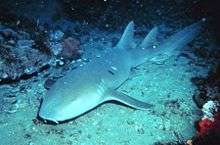Ginglymostoma
Ginglymostoma is a genus of shark in the family Ginglymostomatidae. This fish lives in Brazil, the United States, Colombia, Ecuador, Cape Verde, Morocco, Mauritania, Senegal, the Gambia, Guinea-Bissau, Guinea, Sierra Leone, Liberia, Ivory Coast, Ghana, Togo, Benin, Nigeria, Cameroon, Equatorial Guinea, Republic of the Congo, Angola, the Democratic Republic of the Congo, Gabon, France, Spain, Nicaragua, Saint Lucia, Guatemala, Saint Vincent and the Grenadines, Guyana, Grenada, Suriname, French Guiana, Trinidad and Tobago, Dominica, Martinique, Dominican Republic, Costa Rica, Honduras, Haiti, Jamaica, Puerto Rico, El Salvador, Saint Kitts and Nevis, Turks and Caicos Islands, Guadeloupe, Montserrat, Antigua and Barbuda, Belize, Anguilla, Virgin Islands, Venezuela, Saint Martin, Sint Eustatius, Bonaire, Barbados, Bermuda, Aruba, Mexico, Cayman Islands, and Peru. There are two members in the genus. Members of this genus eat small fish and crustaceans, and are commonly quite lethargic unless provoked. Members of this genus have the ability to suck in water in order to remove snails from their shells in a manner that can be described as 'vacuum-like'.
| Ginglymostoma | |
|---|---|
 | |
| Ginglymostoma cirratum | |
| Scientific classification | |
| Kingdom: | Animalia |
| Phylum: | Chordata |
| Class: | Chondrichthyes |
| Order: | Orectolobiformes |
| Family: | Ginglymostomatidae |
| Genus: | Ginglymostoma J. P. Müller & Henle, 1837 |
Species
There are currently two recognized living species in this genus:
- †Ginglymostoma angolense (Dartevelle & Casier, 1943)
- †Ginglymostoma botmaense Noubhani & Cappetta, 1997
- †Ginglymostoma chenanei Noubhani & Cappetta, 1997
- Ginglymostoma cirratum Bonnaterre, 1788 (nurse shark)
- †Ginglymostoma cuspidata Case, Borodin & Leggett, 2001
- †Ginglymostoma dartevellei Casier, 1946
- †Ginglymostoma delfortriei Daimeries, 1889
- †Ginglymostoma erramii Noubhani & Cappetta, 1997
- †Ginglymostoma khouribgaense Noubhani & Cappetta, 1997
- †Ginglymostoma maghrebianum Casier, 1947
- †Ginglymostoma malembeense Dartevelle & Casier, 1943
- †Ginglymostoma maroccanum Noubhani & Cappetta, 1997
- †Ginglymostoma serra Leidy, 1877
- †Ginglymostoma sokotoense White, 1934
- †Ginglymostoma subafricanum Arambourg, 1952
- Ginglymostoma unami Del-Moral-Flores, Ramírez-Antonio, Angulo & Pérez-Ponce de León, 2015 (Pacific nurse shark) [2]
References
- Sepkoski, J. (2002). "A compendium of fossil marine animal genera (Chondrichthyes entry)". Bulletins of American Paleontology. 364: 560. Archived from the original on 2012-05-10.
- Moral-Flores, L.F.D., Ramírez-Antonio, E., Angulo, A. & Pérez-Ponce de León, G. (2015). "Ginglymostoma unami sp. nov. (Chondrichthyes: Orectolobiformes: Ginglymostomatidae): a new species of nurse shark from the Tropical Eastern Pacific". Revista Mexicana de Biodiversidad. 86: 48–58. doi:10.7550/rmb.46192.CS1 maint: uses authors parameter (link)